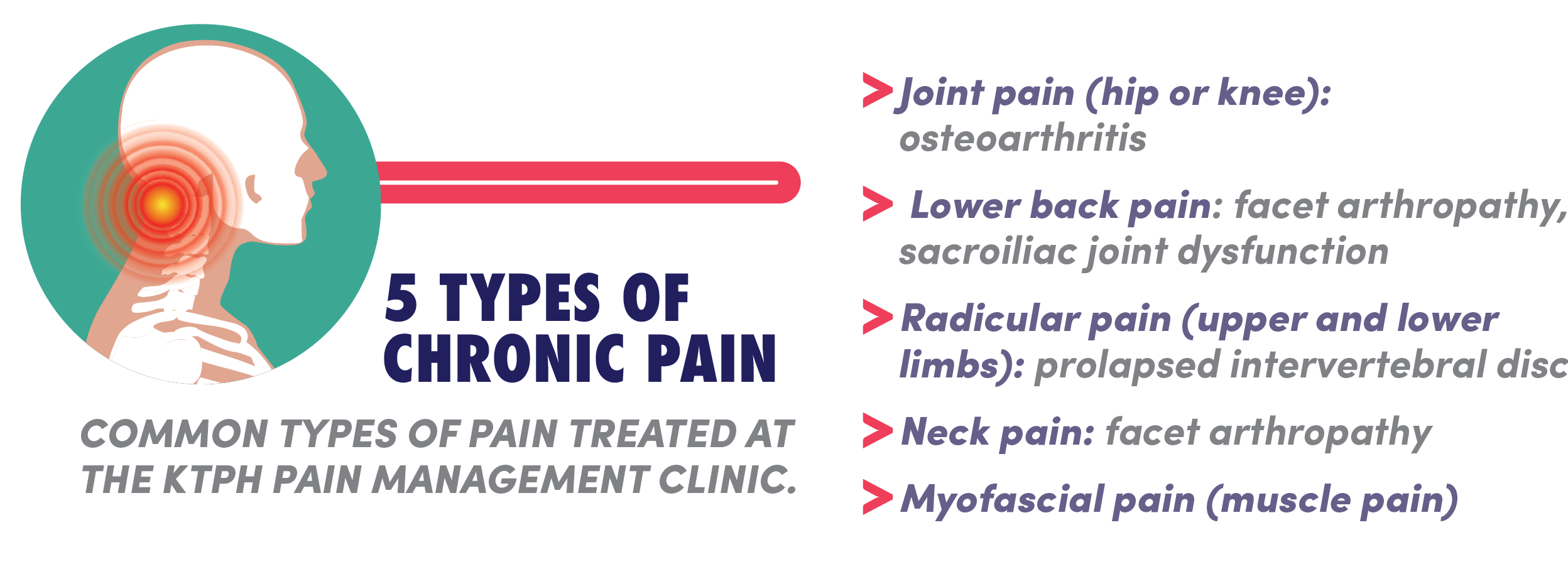Beyond The Hurt
Chronic pain may never go away completely, but proper pain management can offer relief and improve quality of life.
Chronic pain can feel like an invisible burden. It impedes everyday tasks, interrupts sleep, and can make basic actions — such as bending down to tie shoelaces or opening a carton of milk — a challenge. Over time, living with chronic pain not only aff ects physical health, but imposes a burden on one’s emotional and social well-being as well. It also increases the risk of mental health conditions like anxiety and depression, and exacerbates other existing chronic diseases.
Defined as pain lasting beyond three to six months, chronic pain is multifaceted. “The factors that contribute to chronic pain can be both biological and psychological,” says Dr Ashutosh Joshi, Lead Consultant, Pain Service at Khoo Teck Puat Hospital (KTPH)’s Department of anaesthesia, who treats patients at the hospital’s Pain Management Clinic.
These factors change the way the brain processes pain, to feelings of anxiety, depression, or catastrophisation, says Dr Joshi. Catastrophisation is when an individual believes that he/she is in a worse situation than they really are.
Sometimes, the causes of such pain are not immediately apparent. “Nociplastic pain is used to describe this category of pain,” explains Dr Joshi. “It is mechanistically distinct from nociceptive pain (caused by ongoing infl ammation and damage of tissues) and neuropathic pain (caused by nerve damage).”
To put it simply, people with nociplastic pain may feel pain in areas that have no obvious signs of disease or injury. Symptoms of nociplastic pain include widespread or intense pain beyond the affected area, fatigue, insomnia, and cognitive challenges such as memory and mood issues.
The reasons underlying this condition have not been fully understood, but experts theorise that its origin is linked to pain and sensory processing within the central nervous system — which encompasses the brain and spinal cord. Additionally, there are some medical conditions associated with nociplastic pain, including long COVID and chronic disorders such as fibromyalgia.
However, the challenges do not end there. Some individuals go on to develop chronic pain syndrome, a condition where secondary complications arise, intensifying the level of discomfort.
Complications under the umbrella of chronic pain syndrome include:
> Chronic widespread pain (fibromyalgia)
> Complex regional pain syndrome
> Chronic visceral pain (chest pain syndrome, irritable bowel syndrome, abdominal/pelvic pain syndrome)
> Chronic headache and orofacial pain (tension-type of headache, burning mouth pain)
> Chronic musculoskeletal pain
Why Does It Hurts So Bad
The root of chronic pain and how it is perceived by each patient is not always clear-cut. Factors such as the patient’s mental well-being and level of social support can also affect how his/her level of pain is perceived. “Each patient’s response to pain is influenced by a combination of
factors,” says Dr Bin Wern Hsien, Head and Senior Consultant, Department of Anaesthesia at KTPH. “Doctors should always respect a patient’s account of his/her pain, as it could be shaped differently based on individual life experiences.”
For some, chronic pain is rooted in psychological factors such as For some, chronic pain is rooted in psychological factors such as stress, anxiety, and depression, making it particularly challenging to diagnose and address. “It may take several visits before trust is built between the patient and doctor, and before the patient reveals to the doctor that he or she is depressed,” says Dr Bin.
Gathering history from the patient’s caregivers is also important, but some may opt to remain silent in the patient’s presence. “Such cases require patience — a lot of listening and rapport building is often needed. Sometimes, even after we diagnose significant underlying psychological stressors and explain our findings, the patient may still not be keen to seek therapy due to social stigma,” adds Dr Bin.

Addressing The Pain Points
Depending on where the pain originates, treatments vary. At KTPH’s Pain Management Clinic,
a comprehensive approach is adopted. “Our goal is to ascertain the nature and location of the pain,” says Dr Darryl Heng, Consultant, Department of Anaesthesia, KTPH. “We then devise a combination plan involving pharmacology, procedures, physical therapies, and psychological interventions.”
Procedures offered range from nerve blocks, which provide temporary relief, to neurolysis, which intentionally damages certain nerve pathways so that pain signals cannot be transmitted. Medications and complementary therapies like acupuncture may also be incorporated into the treatment plan. Depending on the type of pain and the part of the body it affects, the clinic may refer patients to other departments, such as Sports Medicine, Physiotherapy, Acupuncture, and
Psychological Medicine.
For instance, nerve pain — which originates from nerve aggravation or damage — can manifest in various forms, including burning, tingling, pins-and-needles, or a stabbing sensation. Potential treatments include the use of oral drugs, and procedures like nerve blocks and pulsed radiofrequency.

Myofascial pain (muscle pain), on the other hand, is often characterised by tightness or soreness due to trauma such as impact or over-stretching, resulting in muscle tears. Treatments usually focus on trigger points and might include needling, physical therapies, or nonsteroidal anti-inflammatory drugs.
“The procedures are generally safe. However, as with any medical procedure, there might be potential side effects,” says Dr Heng.
As the causes of pain can be complex, there is no one-size-fits-all therapy. “The approach depends on the patient’s preferences, as well as his cultural beliefs and personal experiences,” says Dr Heng. “A multimodal treatment approach is best to effect better pain control and outcomes, as well as to minimise the need for high-risk treatments such as opioids,” he adds.
Alternative Solutions
Acupuncture has been gaining traction as an effective complementary therapy. “There’s robust evidence supporting acupuncture’s efficacy in pain management,” says Dr Joshi. All major hospitals in Singapore, including KTPH and Tan Tock Seng Hospital (TTSH), provide acupuncture services. Furthermore, acupuncture for chronic neck and lower back pain at public health institutions is also covered by government subsidies.
However, the effectiveness of over-the-counter supplements to ease chronic pain, such as joint
supplements like glucosamine, or nerve supplements like Neuroforte or Vitamin B12, is still debatable.
According to Dr Heng, some patients might benefit from consuming these supplements, while others might not notice any difference. “It’s crucial for patients to maintain a pain diary to gauge the supplement’s effect,” he advises.
Painkillers are safe if the prescribed dosage limit is adhered to. But Dr Bin strongly advises against self-medicating, as some painkillers are unsuitable for certain medical conditions. “Pain
physicians may provide a good day/bad day pain regimen for patients with chronic pain, where
they recommend a baseline daily analgesic regimen, with additional medications to escalate if the pain is especially bad,” he adds. Patients should consult with their doctor if their pain patterns change or intensify.
Read the e-Book of the magazine
hereRead the PDF of the magazine here

